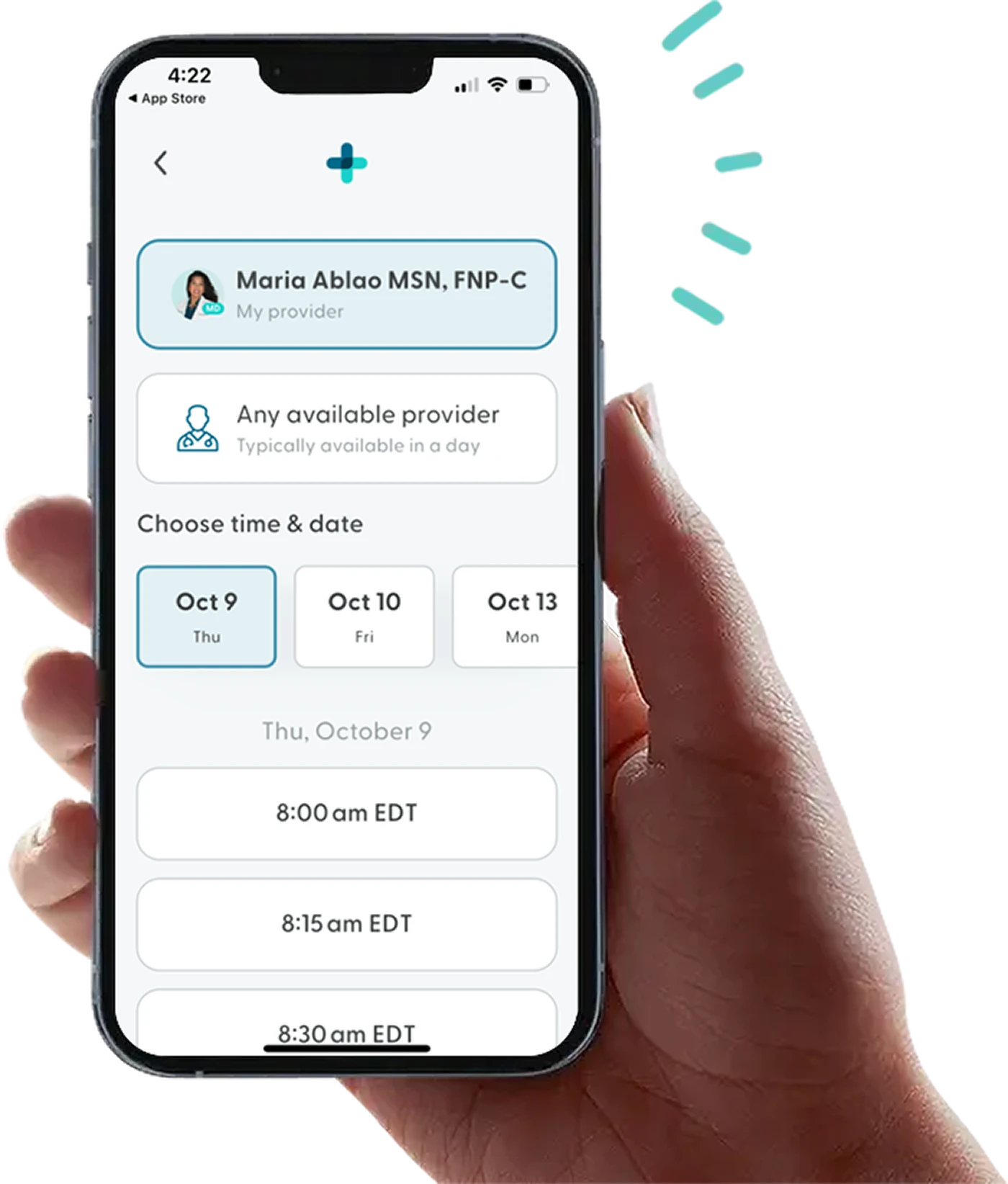Understanding Low Estrogen in Women
Estrogen plays a major role in the female body – regulating everything from your menstrual cycle to your mood, bone health, skin, sleep, and even sex drive. When estrogen levels drop – whether it’s during menopause, after childbirth, or even in your 20s or 30s – it can throw your body (and mind) out of balance. And because the symptoms can show up in unexpected ways, it’s easy to chalk them up to stress, aging, or “just one of those things.”
In this article, we’re breaking down everything you need to know about low estrogen: the signs and symptoms (including some weird ones), what causes it, how it’s diagnosed, what it can do to your body, and how to treat it – especially if it’s affecting your quality of life.
Feel like yourself again
A licensed provider can help you understand your symptoms and determine if hormone replacement therapy is the right next step.


What are Normal Estrogen Levels?
Estrogen levels aren’t static – they rise and fall naturally depending on your age, where you are in your menstrual cycle, and whether you’re pregnant, perimenopausal, or postmenopausal. So what’s considered “normal” can vary a lot from person to person.
For example, during the menstrual cycle, estrogen (specifically estradiol, the most active form) can range anywhere from about 50-550pg/mL, peaking just before ovulation (cycle day 12). In pregnancy, levels shoot up significantly. After menopause, they drop to an undetectable serum level and FSH (follicle stimulating Hormone rises.
Key Point: When Should You Get Your Estrogen Levels Tested?
If you’re experiencing symptoms like irregular periods, unexplained weight changes, vaginal dryness, or mood issues – and they’re starting to impact your day-to-day life – it may be time to talk to your medical provider. A simple blood test can give you a clearer picture of what’s going on.
What is Low Estrogen?
Low estrogen happens when your body isn’t producing enough of this key hormone to support normal functions – and depending on the cause, it can be a short-term dip or a more chronic issue.
While levels can vary based on age and cycle phase, estradiol (the most commonly measured type of estrogen) is typically considered low if it falls below 30 pg/mL in premenopausal women. Postmenopausal levels are naturally much lower, often below 5 pg/mL There are three types of estrogen in the body:
Estradiol (E2): The main type during your reproductive years
Estrone (E1): More common after menopause
Estriol (E3): Primarily produced during pregnancy
When you get your hormone levels checked, estradiol is usually the one tested, since it’s the most active and closely tied to symptoms.
It’s also worth noting that low estrogen isn’t always a long-term issue. It can drop temporarily due to things like stress, over-exercising, or being underweight – and bounce back once the underlying issue is addressed. But if your levels stay low over time (like during perimenopause, menopause, or due to certain health conditions), treatment might be necessary to help you feel like yourself again.
How Do I Know I Have Low Estrogen and Not Something Else?
The short list is familiar to many:
Hot flashes and night sweats that disrupt sleep
3 a.m. awakenings
Mood flatness, irritability, or anxiety swings
Word-finding gaps and lagging focus (brain fog)
Headaches and new joint aches
Vaginal dryness, pain with sex, urinary urgency or recurrent UTIs
Drier skin and increased hair shedding
Chaotic menstrual cycles and heavier or lighter bleeding with bigger PMS swings (perimenopause specific)
The truth is, low estrogen can look different for everyone. Some people experience a handful of symptoms; others feel like their whole body is out of sync. That’s why diagnosing low estrogen involves more than just going off how you feel.
Here’s how it’s typically done:
Symptom tracking: Keeping a journal of what you’re experiencing – like sleep issues, hot flashes, and brain fog related to cycle timing – can help your provider spot a pattern.
Blood tests: A simple blood test can measure your estrogen levels – most often estradiol – to determine whether they’re in a healthy range for your age and stage of life. For those still having menstrual cycles, testing around day 12 (when estradiol peaks) and day 21 (when progesterone peaks) can provide the most insight. However, even if your lab results come back “normal,” that doesn’t always mean your hormones are balanced. It’s possible to experience significant symptoms from fluctuations that a single estradiol reading can easily miss.
Medical provider consultation: A HRT-trained healthcare provider will consider your symptoms, medical history, and lab results before making a diagnosis or recommending treatment.
While it’s tempting to self-diagnose based on what you read online, estrogen levels are complex – and symptoms can overlap with other health conditions like thyroid disorders or vitamin deficiencies. The safest way to know if you have low estrogen is to speak with a medical professional who can help you get a clear diagnosis and the right support.
What Causes Low Estrogen?
There are several reasons your estrogen levels might dip, and not all of them are tied to menopause.
Natural aging and menopause
As you get older, your ovaries gradually produce less estrogen. This drop typically starts during perimenopause (usually in your 40s) and continues after menopause, when estrogen levels become undetectable.
Surgical menopause
If you’ve had your ovaries removed (oophorectomy), your body loses its primary source of estrogen overnight. This is sometimes called “surgical menopause” and often causes more sudden and intense symptoms.
Certain medications or treatments
Some cancer treatments like chemotherapy or radiation can damage the ovaries, leading to lower estrogen levels. Hormonal therapies (like those used for endometriosis or breast cancer) can also suppress estrogen on purpose.
Autoimmune disorders
Conditions like Addison’s disease or autoimmune ovarian failure can interfere with estrogen production, especially if the immune system mistakenly targets hormone-producing tissues.
Excessive exercise or disordered eating
If your body doesn’t have enough energy (due to overtraining, undereating, or very low body fat), it may shut down estrogen production to conserve resources – often leading to missed periods and other symptoms.
Genetics or premature ovarian insufficiency (POI)
Some women experience significantly lower estrogen levels before age 40 due to genetic conditions or unknown causes. This is often called premature ovarian insufficiency, and is essentially an early menopause.
Symptoms Associated with Low Estrogen
Estrogen does more than regulate your menstrual cycle – it influences everything from your skin and hair to your mood and metabolism. That’s why low estrogen symptoms can show up in ways that might surprise you. And if you’re wondering whether you’re dealing with hormone imbalance, recognizing the signs of low estrogen in women is a good place to start.
Physical symptoms
These are often the most noticeable – and they’re usually what bring people to the doctor first.
Hot flashes and night sweats
Vaginal dryness
Irregular or missed periods
Fatigue and low energy
Thinning hair or hair loss
Weight changes
Emotional and mental symptoms
Low estrogen doesn't just affect your body – it can also influence your brain chemistry and mood. Symptoms may include:
Mood swings
Irritability
Anxiety or depression
Brain fog or difficulty concentrating
Sexual and reproductive symptoms
Estrogen plays a key role in sexual health and fertility, so drops in hormone levels can affect both.
Pain during sex
Fertility issues
Genitourinary symptoms
“Weird” symptoms
Not every symptom is obvious — some are subtle or unexpected. These weird symptoms of low estrogen can fly under the radar but still affect your quality of life:
Joint pain or stiffness: Estrogen helps maintain joint health and inflammation levels
Tinnitus (ringing in the ears): Some women report a buzzing or ringing sound as hormones shift
Burning mouth syndrome: A strange tingling, burning, or numbness in the tongue or lips
Increased sensitivity to allergens or environmental changes: Estrogen helps regulate the immune system
Skin crawling sensations: Also called formication, this can feel like bugs under your skin
Change in body odor: Hormone fluctuations can alter how your sweat smells
The Impact of Low Estrogen
Estrogen levels that remain low for prolonged periods – especially without treatment or intervention – may negatively impact your long-term health. These effects are typically more uncomfortable than symptoms like hot flashes or mood swings. Over time, chronically low estrogen can contribute to more serious health concerns, particularly after menopause.
Osteoporosis and bone loss
Estrogen helps maintain bone density by slowing the natural breakdown of bone. When levels drop, that protective effect weakens and can lead to thinner, more fragile bones. Without enough estrogen, women are at higher risk for osteopenia, osteoporosis, and even fractures from minor falls.
Cardiovascular issues
Estrogen has heart-protective qualities, including helping to keep blood vessels flexible and supporting healthy cholesterol levels. After menopause, as estrogen declines, the risk of heart disease, stroke, and high blood pressure can rise – especially if other risk factors are present.
Weight gain and metabolic changes
Low estrogen can contribute to slower metabolism, increased fat storage around the abdomen, and shifts in how your body regulates insulin. These changes can make it harder to maintain a healthy weight and may increase the risk of type 2 diabetes.
Urogenital atrophy
Estrogen supports the health of vaginal and urinary tissues. When levels drop, those tissues can become thinner, drier, and less elastic. This can lead to vaginal dryness, painful intercourse, frequent UTIs, and even urinary incontinence – a group of symptoms collectively known as urogenital atrophy.
Where Can I Learn More About Hormonal Balance?
If you're experiencing symptoms associated with low estrogen, you don’t have to tough it out alone. With personalized hormone therapy, expert guidance, and support that fits your life, getting back to balance is more accessible than ever.
Make your online appointment today to see if you qualify and take the first step toward feeling like you again.
More articles like this
Feel better with LifeMD.
Your doctor is online and ready to see you.
Join LifeMD for seamless, personalized care — combining expert medical guidance, convenient prescriptions, and 24/7 virtual access to urgent and primary care.

HRT Support
Talk with a provider about whether hormone replacement therapy is right for you.
Get Started Now
 Medically reviewed and edited by
Medically reviewed and edited by 









